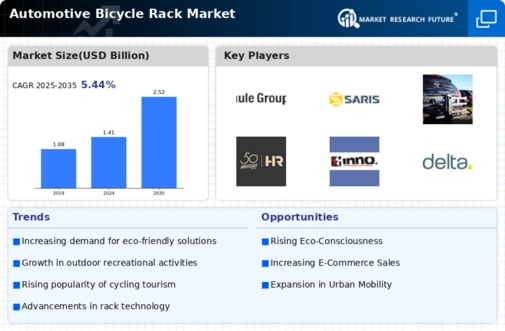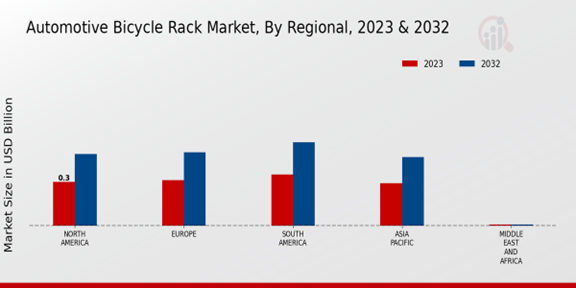Rising E-Bike Adoption
The surge in electric bicycle (e-bike) adoption significantly influences the Global Automotive Bicycle Rack Market Industry. E-bikes are becoming increasingly popular due to their convenience and ability to cover longer distances with less effort. This trend is particularly evident in urban environments where commuting distances are often longer. As e-bike sales continue to rise, the demand for specialized bicycle racks that accommodate their unique designs and weights is expected to grow. The market is projected to expand to 2.52 USD Billion by 2035, indicating a robust growth trajectory driven by the evolving preferences of consumers seeking efficient and sustainable transportation solutions.
Market Growth Projections
The Global Automotive Bicycle Rack Market Industry is poised for substantial growth, with projections indicating a market value of 1.41 USD Billion in 2024 and an anticipated increase to 2.52 USD Billion by 2035. This growth trajectory suggests a robust demand for bicycle racks driven by various factors, including the rising popularity of cycling, technological advancements, and supportive government initiatives. The compound annual growth rate (CAGR) of 5.42% from 2025 to 2035 further underscores the market's potential as consumers increasingly prioritize sustainable transportation solutions. These projections highlight the evolving landscape of the bicycle rack market and the opportunities it presents for manufacturers and retailers.
Growing Popularity of Cycling
The increasing popularity of cycling as a recreational and commuting activity drives the Global Automotive Bicycle Rack Market Industry. As urban areas become more congested, individuals are seeking alternative modes of transportation, with bicycles emerging as a favored choice. This trend is supported by government initiatives promoting cycling infrastructure and environmental sustainability. In 2024, the market is projected to reach 1.41 USD Billion, reflecting a growing consumer base that prioritizes eco-friendly transportation options. The rise in cycling events and community programs further enhances the demand for bicycle racks, as more individuals invest in bicycles and the necessary accessories to transport them.
Increasing Outdoor Activities and Tourism
The rise in outdoor activities and tourism contributes to the growth of the Global Automotive Bicycle Rack Market Industry. As more individuals engage in recreational cycling, the demand for bicycle racks that facilitate travel to various destinations increases. This trend is particularly pronounced in regions with scenic cycling routes and national parks, where cycling is a popular activity among tourists. The integration of bicycle racks in vehicles enhances the convenience of transporting bicycles, thereby encouraging more people to explore outdoor adventures. The market's expansion aligns with the broader trend of promoting active lifestyles and outdoor tourism, further solidifying the role of bicycle racks in facilitating these experiences.
Technological Advancements in Bicycle Racks
Technological advancements in bicycle rack design and functionality are propelling the Global Automotive Bicycle Rack Market Industry forward. Innovations such as lightweight materials, foldable designs, and enhanced security features are making bicycle racks more user-friendly and appealing to consumers. Manufacturers are increasingly focusing on integrating smart technology, such as GPS tracking and theft deterrent systems, into their products. These advancements not only improve the overall user experience but also cater to the growing demand for high-quality, durable products. As a result, the market is expected to witness a compound annual growth rate (CAGR) of 5.42% from 2025 to 2035, reflecting the industry's adaptability to consumer needs.
Government Initiatives and Infrastructure Development
Government initiatives aimed at promoting cycling and developing related infrastructure play a crucial role in shaping the Global Automotive Bicycle Rack Market Industry. Many governments are investing in cycling lanes, bike-sharing programs, and public awareness campaigns to encourage cycling as a sustainable mode of transport. These initiatives not only enhance the visibility of cycling but also create a supportive environment for bicycle ownership and transportation. As infrastructure improves, the demand for bicycle racks is likely to increase, reflecting the growing integration of cycling into urban mobility strategies. This supportive regulatory framework is expected to drive market growth and foster a culture of cycling in communities worldwide.






















Leave a Comment